Two small radios from France. Restoration and review.
Posts: 64
Threads: 5
Joined: Apr 2025
City: SPRUCE GROVE
State, Province, Country: Alberta
France
Peculiarities of national character.
Excelsior-52 threw me off track. It was too far outside my established idea of what a household radio receiver is. Even despite the knowledge that it was a direct predecessor of Zvezda, nevertheless, not only a completely unique design, but also purely radio-technical filling significantly differed from familiar Soviet and American schools.
This interest prompted me to expand the French collection and acquire a couple more fairly bright representatives of a very specific French view on radio.
In the process of their restoration, the already established stereotypes about the peculiarities of the French nation were fully reinforced. Which is more than clearly seen in the example of these devices, which I will present from all angles.
To begin with, also a link to a detailed gallery of my first Frenchman - the famous Excelsior-52 prototype of the no less famous Zvezda-54, ripped off from it in design one to one.
Star-54 - Excelsior-52
This is how these two nice Frenchmen arrived to me.
Small, cute and big-eared Frenchie JS Radio Paris.
And another one, without ears and bigger - Sonaphone Prélude P6.
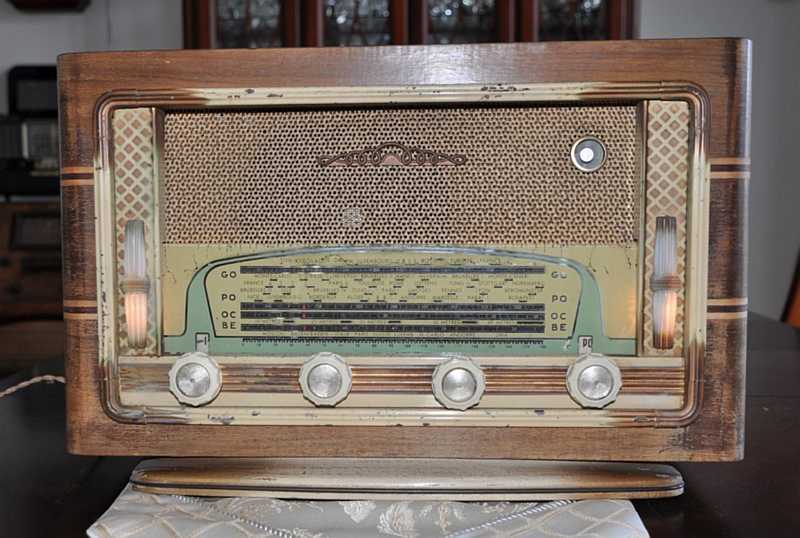
If the first one was a solid four, then the second one was a three at most, both externally and internally.
So we begin to bring both representatives of French radio design to a form as close to the original as possible.
The first one will be JS - the eared one. The second one will be Sonaphone Prélude P6.
Let me remind you that both receivers are completely different. Different companies, different class of devices, released with a difference of 3-4, or even more, years, the baby on finger lamps, the nameless on rimlocks, the baby's speaker already with a permanent magnet, the big one still with a magnetization coil. And yet, it seems that they were made on neighboring workbenches on the same day, and by the same crooked hands the chassis and assembly, and by a half-mad artist from the Seine embankment the body and the entire appearance.
So let's start to analyze.
Posts: 64
Threads: 5
Joined: Apr 2025
City: SPRUCE GROVE
State, Province, Country: Alberta
Chassis removed, front view:
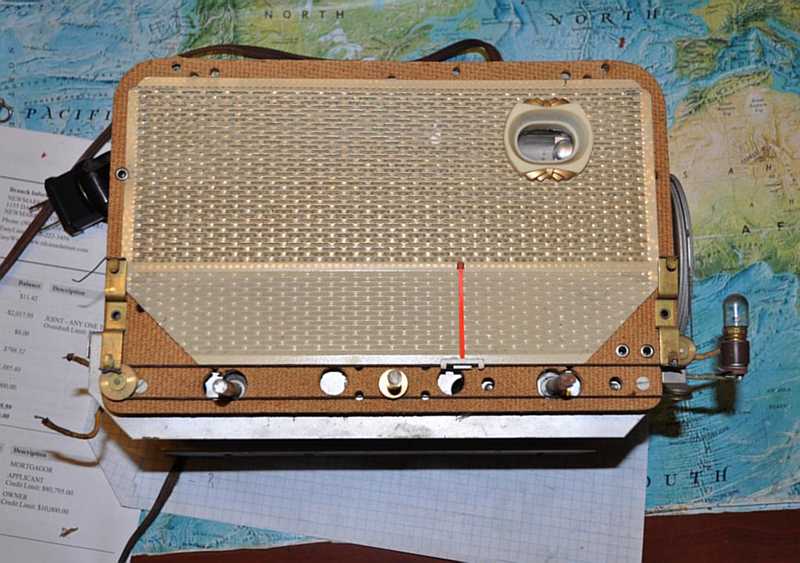
Chassis rear view:
It will be enough for the first device to prescribe a bath.
But the second device turned out to be much worse, the rust was serious.
I'll have to get down to painting in earnest.
And although the baby has already acquired a magnetic antenna and a permanent magnet in the loudspeaker, otherwise it's a complete déjà vu when comparing them. The transistors are from the same machine, the chassis is from the same barrel, the front panels are the same ..., only a side view.
(This post was last modified: 04-25-2025, 10:50 PM by Vlad95.)
Posts: 64
Threads: 5
Joined: Apr 2025
City: SPRUCE GROVE
State, Province, Country: Alberta
(This post was last modified: 04-25-2025, 10:52 PM by Vlad95.)
Posts: 64
Threads: 5
Joined: Apr 2025
City: SPRUCE GROVE
State, Province, Country: Alberta
(This post was last modified: 04-25-2025, 10:53 PM by Vlad95.)
Posts: 64
Threads: 5
Joined: Apr 2025
City: SPRUCE GROVE
State, Province, Country: Alberta
One is ready for washing, the other for painting:
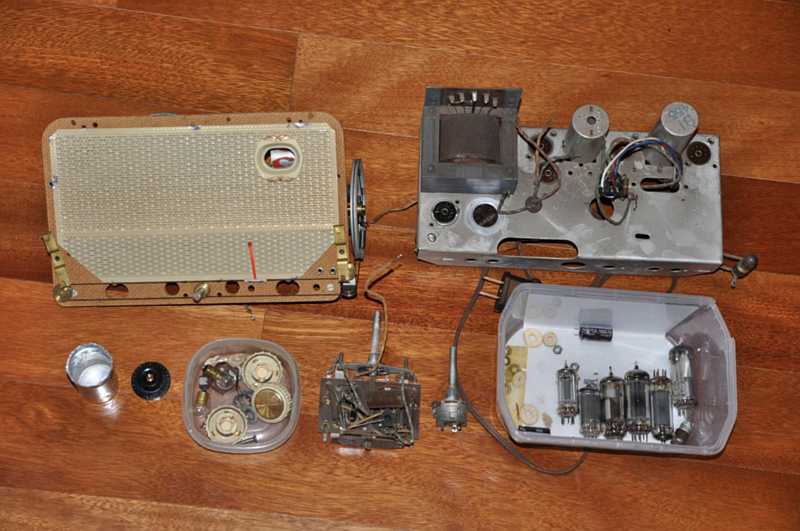
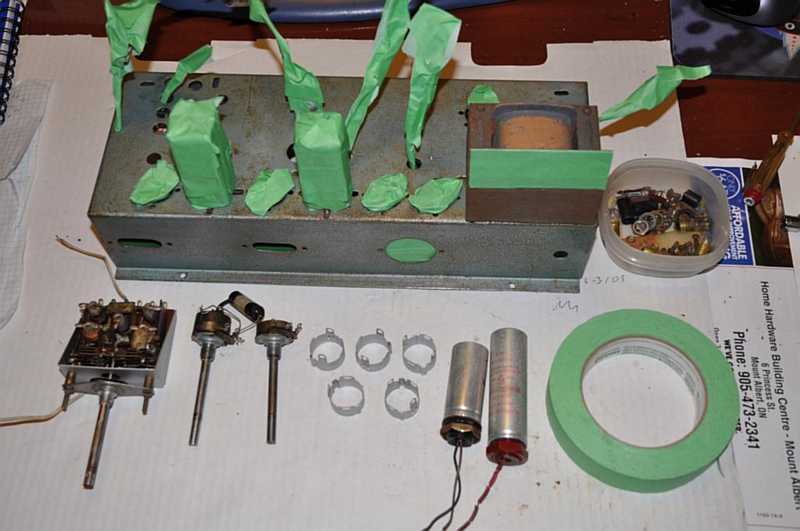 ATTENTION!!!
ATTENTION!!!
Faint-hearted and heart patients,
please do not look!
Go straight to the next picture!:
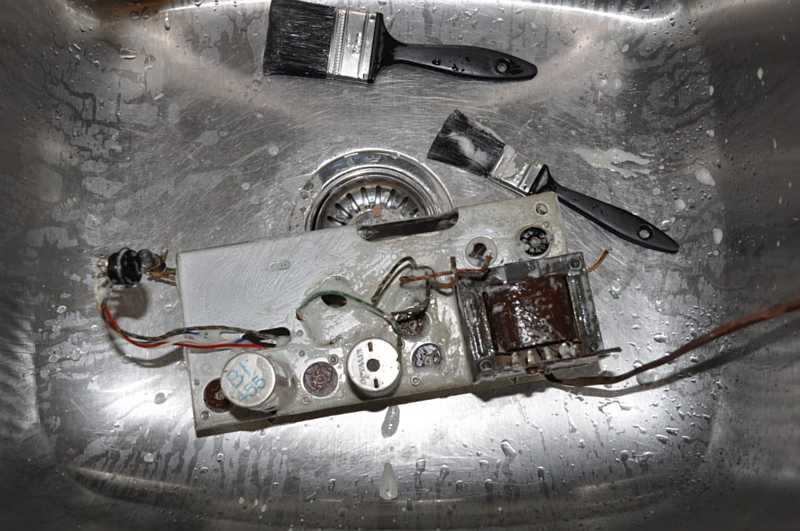
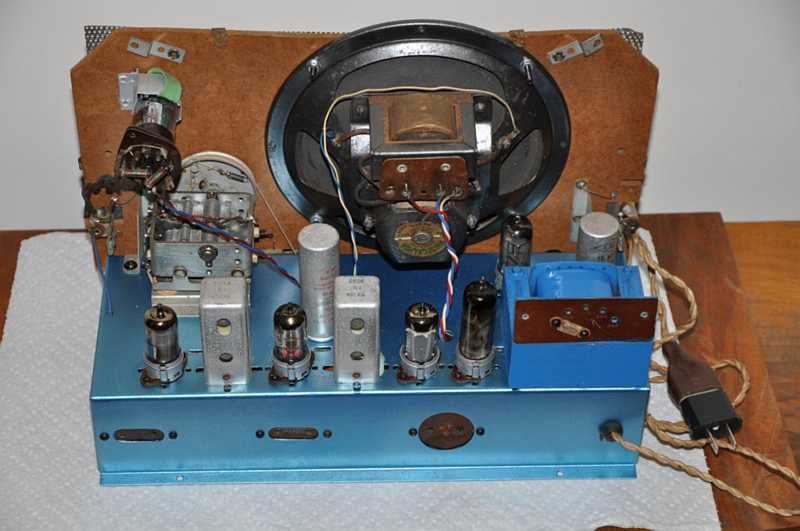
The setup went quite smoothly. Considering the wretchedness of the circuit diagram, much worse was expected and the readiness for a battle with the pairing was increased. But surprisingly, everything worked out without problems. Despite the fact that the overview and extended HF have the same circuit, and are switched only by additional capacity. Nevertheless, everything fit as expected. Their unkind words were given to those who came up with such a set of ranges:
GO - LW 1000-2000m
PO - MW 200-550m
OC - SW 1 16-50m
BE - SW 2 46-50m
What the H**l.
But the sensitivity at a glance is quite decent.
Restoration of cabinets.
It was necessary to glue the joints, fill the veneer and chips. JS only needed to work with Restore-a-Finish.
But the second one went through Danish Oil first, didn't like it. Covered it with shellac. It turned out what I wanted, not quite a mirror, but exactly the same texture as it was originally.
(This post was last modified: 04-25-2025, 11:07 PM by Vlad95.)
Posts: 64
Threads: 5
Joined: Apr 2025
City: SPRUCE GROVE
State, Province, Country: Alberta
And here they are, the French beauties ready:
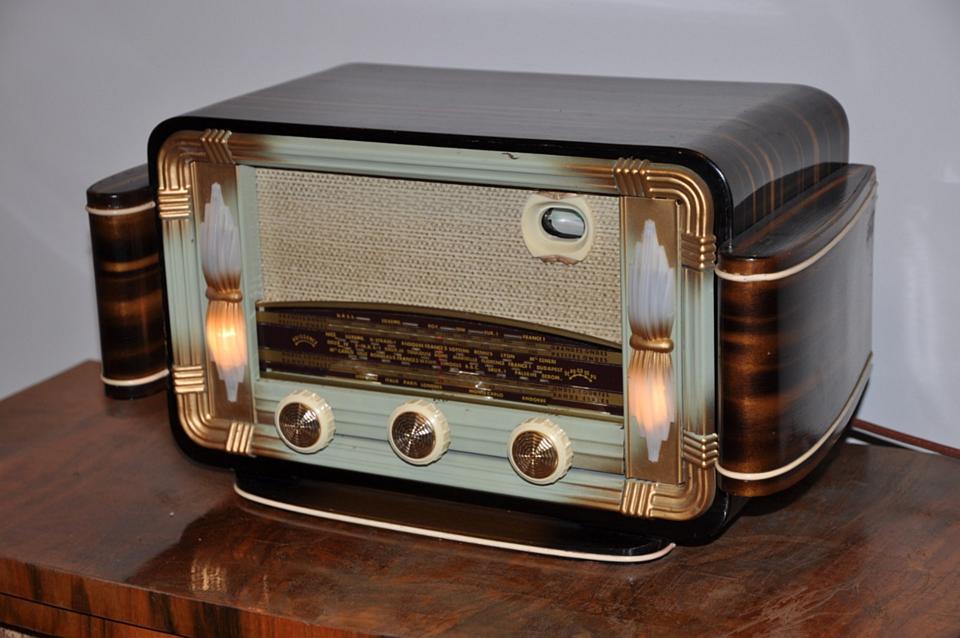
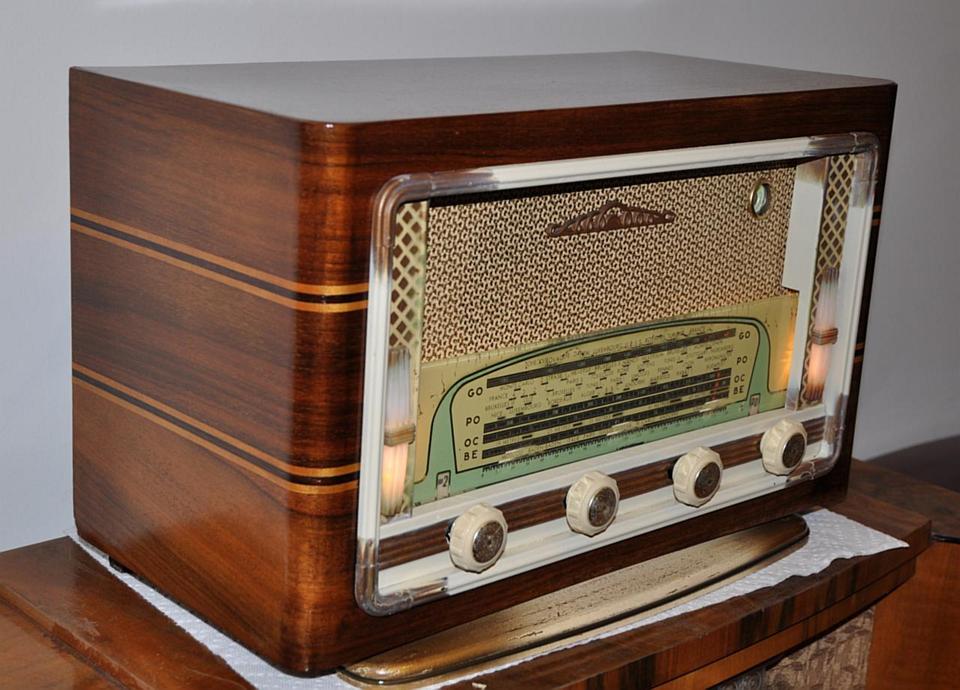
In summary, the suspicion that radio transmits the national character traits of its country of origin has been fully confirmed.
A completely fantasy-boudoir design and God knows what the French have in the filling.
The Germans have a design that is so meticulously polished that it seems insane, with the elegance of a cinder block.
Americans - so that 100 pieces on a conveyor belt can be assembled by 2 blacks in an 10 hour and all 100 pieces work as one.
(This post was last modified: 04-26-2025, 10:35 AM by Vlad95.)
Posts: 656
Threads: 22
Joined: Nov 2014
City: Svalyava. Transkarpatia
State, Province, Country: Ukraine
Hello, Vlad. I agree with your description of French radios. I might add that they are made like French cars – extravagant and beautiful, but which rust terribly after 5...8 years. I had two French radios, very similar in appearance and design to your Sonaphone Prélude P6. Both were very rusty and I had to completely repaint them. Also, both radios had almost identical chassis to your Sonaphone. Yes, I also got the impression that they were assembled somewhere in a garage, not at a factory. After getting to know them, I lost interest in French radios for about 5 years. However, five years ago I bought three other French ones again and changed my opinion about them to a much better one and came to the conclusion that the terrible quality was typical of the period 1948-53, perhaps because those were difficult times for France.
My 1950 Perfecta after restoration
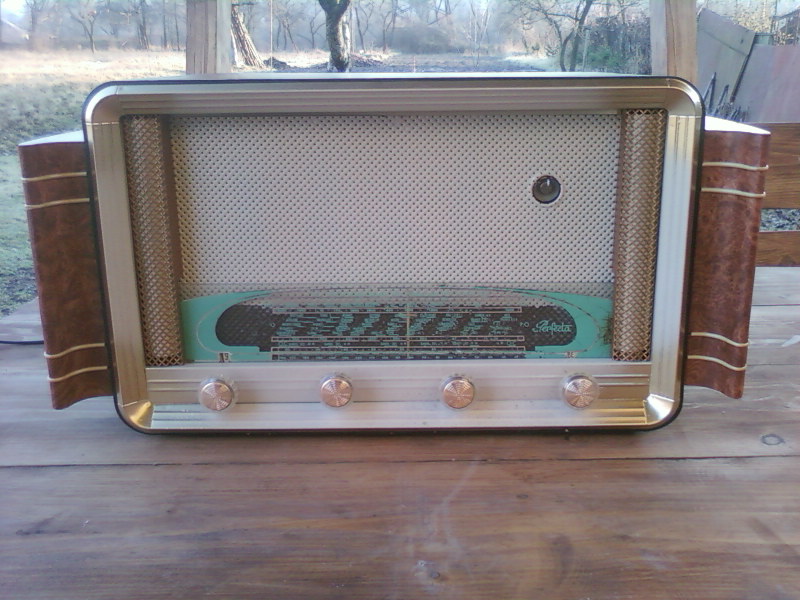
My 1950 Ducastelle, also after restoration

Pay attention to the Ducastelle handles... Doesn't it remind you of anything? 
Ретро радіо музей ТБ. Antique Radio MuseumTV
https://www.youtube.com/user/RadioSvit
Sincerely Peter
З повагою Петро
(This post was last modified: 04-27-2025, 11:48 AM by RadioSvit.)
Posts: 4,945
Threads: 54
Joined: Sep 2008
City: Sandwick, BC, CA
Greetings;
I think that it's possible that the assortment of components was the result of post war parts shortages, as for the rough quality of assembly it could be due to the sets being built by small (what they would now call) start up companies. I've seen such things in North American radios from the post war period as well, sets that used filed coil speakers in some examples, and permanent magnet dynamic speakers in others, tubes that were substituted, pre war DOT coded resistors, military surplus tube types. I don't know if anyone else has noticed but there were also a number of AC/DC, and farm battery sets that were NOT portables, that were produced with cloth covered cabinets in this period rather then Bakelite or finer woods, some were made out of cheaper woods and covered with a dark finish or faux wood grain.
However there were also a lot of small newer brands, or manufacturers, that appeared during this time, produced one or two models for a few years or so, then disappeared. One Canadian company was called Brand and Millen, another was an American company called "Telesonic", another was called "Minerva". The Telesonic set is interesting, it's a six tube, hot chassis, AC/DC set, with an untuned RF amplifier stage, using all loctal type tubes, even the rectifier, and power output tubes, even Philco moved away from doing this by 1947. One unusual detail of the Telesonic is that it used a fixed bias supply for the audio output section, so it has power resistors in series with the B- side to supply this much like a set from the 1930s.
Regards
Arran
Users browsing this thread: 1 Guest(s)
|
|
Recent Posts
|
|
Philco 37-116 Cabinet Repair
|
| Hello Guys,
What I would do is get colors of wax filler and fill in the void !
Sincerely Richardradiorich — 12:41 AM |
|
Philco 37-116 Cabinet Repair
|
| It looks to me like the structure under the veneer may have expanded from humidity cracking the veneer on the surface. W...Arran — 09:42 PM |
|
Help with Supreme 599
|
| Iam only getting 4vac out of the tranny
For the 80 filament. The line rheostat
Looks fine and the tranny is getting 11...daveone23 — 08:45 PM |
|
Rogers Majestic R-646
|
| Transformers rewind?
It's very easy!
If you don't have round eyes 8-)
Vlad95 — 01:55 PM |
|
Help with Supreme 599
|
| I found a broken wire from the end og the 300 ohm line adjust to the transforner but i dont think its needed. The transf...daveone23 — 11:43 AM |
|
Philco 38-10 Tuning Condenser
|
| RodB
I have been using pure Vaseline for a long time for thick lubrication of home radio devices. The main reason is t...Vlad95 — 10:58 AM |
|
Philco 38-10 Tuning Condenser
|
| Vlad, your comment about Vaseline brought a thought. Does anyone know the long term affect on using silicon grease on t...RodB — 10:34 AM |
|
Philco 42-345 Restoration/Repair
|
| Arran, didn't notice the specifics for the caps. What's the code going to get me? I'm working on restoring a Philco 50-9...RodB — 10:26 AM |
|
Philco 38-10 Tuning Condenser
|
| I managed to get the gears lined up and the springs back in. Much easier than it thought. Putting a thin wire down insid...dconant — 09:52 AM |
|
Philco 42-345 Restoration/Repair
|
| Rod, Mrfixr55 and everyone else thank you very much for all your help with this radio thus far. Today will be more testi...osanders0311 — 09:26 AM |
|
Who's Online
|
| There are currently no members online. |

|
 
|
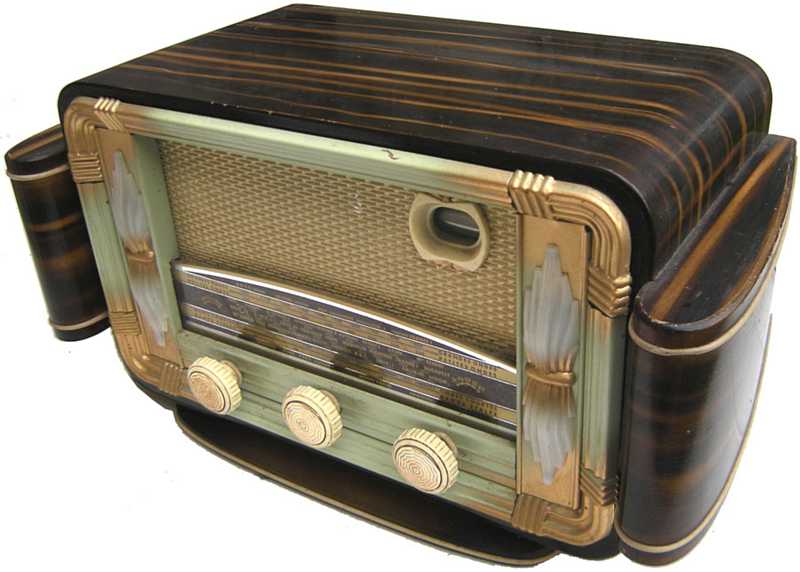




![[-] [-]](https://philcoradio.com/phorum/images/bootbb/collapse.png)


